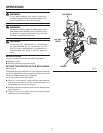
14
15
MAINTENANCE
WARNING:
This tool should never be connected to a power
supply when you are performing maintenance.
Disconnecting the tool will prevent accidental
starting that could cause serious injury.
BRUSH REPLACEMENT
See Figure 12.
The drill has externally accessible brush assemblies that
should be periodically checked for wear.
To replace the brushes:
n
Unplug the drill.
n
Using a T10 torx screwdriver, remove the screw that holds
the brush cap cover in place.
n
Remove the brush cap with a flat blade screwdriver. The
brush assembly is spring loaded and will pop out when
you remove the brush cap.
n
Remove the brush assembly (brush and spring).
n
Check for wear. If worn, always replace in pairs. Do not
replace one side without replacing the other.
n
Replace the old brush assembly with a new one.
n
Place the brush cap on the brush assembly and tighten
with the flat blade screwdriver.
n
Place the brush cap cover on the brush assembly and
tighten with the torx screwdriver.
WARNING:
When servicing use only identical RIDGID
replacement parts. Use of any other parts may
create a hazard or cause product damage.
WARNING:
Always wear safety goggles or safety glasses with
side shields during power tool operation or when
blowing dust. If operation is dusty, also wear a
dust mask.
GENERAL MAINTENANCE
Avoid using solvents when cleaning plastic parts. Most
plastics are susceptible to damage from various types of
commercial solvents and may be damaged by their use. Use
clean cloths to remove dirt, dust, oil, grease, etc.
WARNING:
Do not at any time let brake fluids, gasoline,
petroleum-based products, penetrating oils, etc.,
come in contact with plastic parts. Chemicals can
damage, weaken or destroy plastic which may
result in serious personal injury.
Electric tools used on fiberglass material, wallboard, spack-
ling compounds, or plaster are subject to accelerated wear
and possible premature failure because the fiberglass chips
and grindings are highly abrasive to bearings, brushes, com-
mutators, etc. Consequently, we do not recommended using
this tool for extended work on these types of materials. How-
ever, if you do work with any of these materials, it is extremely
important to clean the tool using compressed air.
LUBRICATION
All of the bearings in this tool are lubricated with a sufficient
amount of high grade lubricant for the life of the unit under
normal operating conditions. Therefore, no further lubrication
is required.
Fig. 12
BRUSH
ASSEMBLY
BRUSH
CAP
SCREW
BRUSH CAP
COVER


















